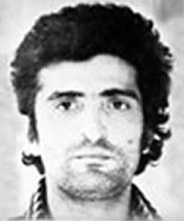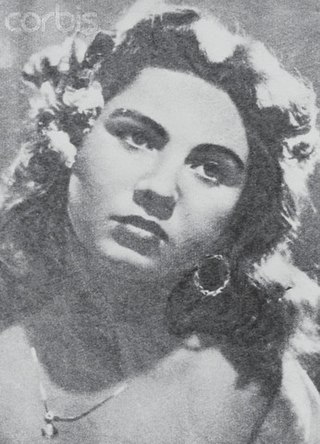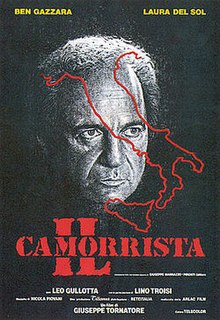The Camorra is an Italian Mafia-type criminal organization and criminal society originating in the region of Campania. It is one of the oldest and largest criminal organizations in Italy, dating to the 17th century. The Camorra's organizational structure is divided into individual groups also called "clans". Every capo or "boss" is the head of a clan, in which there may be tens or hundreds of affiliates, depending on the clan's power and structure. The Camorra is considered by the Italian Government to be the most violent and murderous criminal organization in Italy. The Camorra's main businesses are drug trafficking, racketeering, counterfeiting, and money laundering. It is also not unusual for Camorra clans to infiltrate the politics of their respective areas.

Antonio Gava was an Italian politician and member of Christian Democracy (DC). Son of the 13-time minister Silvio Gava, Antonio was one of the Christian Democratic Party's leading power-brokers in Campania over a 25-year period, beginning in 1968 and ending in 1993, when he was charged with membership of a criminal organisation. Together with Arnaldo Forlani and Vincenzo Scotti, he was the leader of DC's current known as "Alleanza Popolare".

Michele Zaza was a member of the Camorra criminal organisation who was also initiated in the Sicilian Mafia. He headed the Zaza clan in Naples. Zaza was known as ’O Pazzo due to his outspoken and implausible public statements. He was one of the first Camorristi to emerge as a powerful organiser of the cigarette contraband industry in the 1960s and 1970s.

Raffaele Cutolo was an Italian crime boss, leader of the Nuova Camorra Organizzata (NCO), an organisation he built to renew the Camorra. Cutolo had a variety of nicknames including 'o Vangelo, 'o Princepe, 'o Professore and 'o Monaco. Apart from 18 months on the run, Cutolo lived entirely in maximum-security prisons or psychiatric prisons after 1963. At the time of his death he was serving multiple life sentences for murder.
The Nuova Famiglia was an Italian Camorra confederation created in the 1970s and headed by the most powerful Camorra bosses of the time, Carmine Alfieri, the Nuvoletta brothers, Michele Zaza, Luigi Giuliano and Antonio Bardellino, to face Raffaele Cutolo's Nuova Camorra Organizzata, and affiliated with the Sicilian Mafia.

Vincenzo Casillo was an Italian Camorrista and the second in command of the Nuova Camorra Organizzata, a Camorra organization in Naples. His nickname was 'o Nirone.
The Nuova Camorra Organizzata was an Italian Camorra criminal organization founded in the late 1970s by a Neapolitan Camorrista, Raffaele Cutolo, in the region of Campania. It was also known by the initials NCO. The organization was established with the purpose of renewing the old rural Camorra, which dealt in contraband cigarettes and extortion schemes in the Neapolitan fruit market. To this end, Cutolo created a structured and hierarchical organization, in stark contrast to the traditional Camorra clans which are usually fragmented. The members of the NCO were often referred to by rival Camorristi and Italian law enforcement as "Cutoliani".
Giovanni Pandico is a former Italian Camorrista who was a member of the Nuova Camorra Organizzata (NCO), a Camorra organization in Naples. Pandico rose to become one of Camorra boss, Raffaele Cutolo's underwriters within the organization. After twelve years of imprisonment, he decided to collaborate with Italian justice and subsequently became a pentito in 1983. Pandico's revelations brought a massive crackdown on the NCO and led to the arrests of over 856 NCO members and affiliates on June 17, 1983, a day labeled by the Neapolitan press as the black day of the NCO.
Pasquale D'Amico is a former Italian Camorrista who was a senior member of the Nuova Camorra Organizzata (NCO), a Camorra organization in Naples. His nickname was 'o Cartunaro. D'Amico defected from the NCO and subsequently became a pentito in 1983. Among the pentiti, D'Amico was one of the highest-ranking due to his position within the NCO. He was the first high-ranking NCO informant to reveal Neapolitan crime boss, Raffaele Cutolo links with the Calabrian 'Ndrangheta.
Luigi Giuliano is a former Italian Camorrista who was the boss of the powerful Giuliano clan based in the district of Forcella, Naples. He had multiple nicknames including "'o rre" and "Lovigino", which is an amalgamation of Luigi and love. In 2002, he decided to collaborate with Italian law enforcement and became a pentito, a co-operating witness against organised crime.
Mario Fabbrocino was a powerful Italian crime boss of the Camorra – the Neapolitan mafia.

The Vollaro clan is a Neapolitan Camorra clan operating in the area east of Naples, more specifically in the town of Portici and San Sebastiano al Vesuvio, a small village in the Vesuvius area.
The Scissionisti di Secondigliano or Amato-Pagano clan is a Camorra clan from the Secondigliano district of Naples, headed by Raffaele Amato and Cesare Pagano. They are also known as "Spagnoli" (Spaniards) because of their strong presence in Spain, particularly in Costa del Sol and Barcelona.
Giuseppe Puca was an Italian Camorrista, and the right hand of Raffaele Cutolo, boss of the Nuova Camorra Organizzata (NCO). He was known among criminal circles as 'o Giappone, due to his Japanese looks.

Assunta "Pupetta" Maresca was an Italian criminal who was a well-known figure in the Camorra. She made international newspaper headlines in the mid-1950s when she killed the murderer of her husband in revenge.
Rosetta Cutolo is the sister of the Camorra boss Raffaele Cutolo, the head of the Nuova Camorra Organizzata (NCO), an organisation he built to renew the Camorra. As her brother spent most of his time behind bars from where he sent out his instructions, the everyday running of the enterprise was entrusted to Cutolo. Her nickname was Uocchie 'e gghiaccio, meaning "ice eyes".
Lorenzo Nuvoletta was the head of the Nuvoletta clan, a Neapolitan Camorra organization that operated from the town of Marano di Napoli, situated on the northern outskirts of the city of Naples. Nuvoletta was considered one of the most powerful bosses in the entire Camorra from the 1970s to the early 1990s.
The De Luca Bossa clan is a Neapolitan Camorra clan operating in the eastern suburbs of Naples, and more specifically in the area of Ponticelli and in the municipality of Cercola.
Ciro Mazzarella was a historical Italian Camorrista, known in the media as the "king of cigarette smuggling", founder of the Mazzarella clan and was one of the last remaining leaders of a bygone era of the Camorra.






